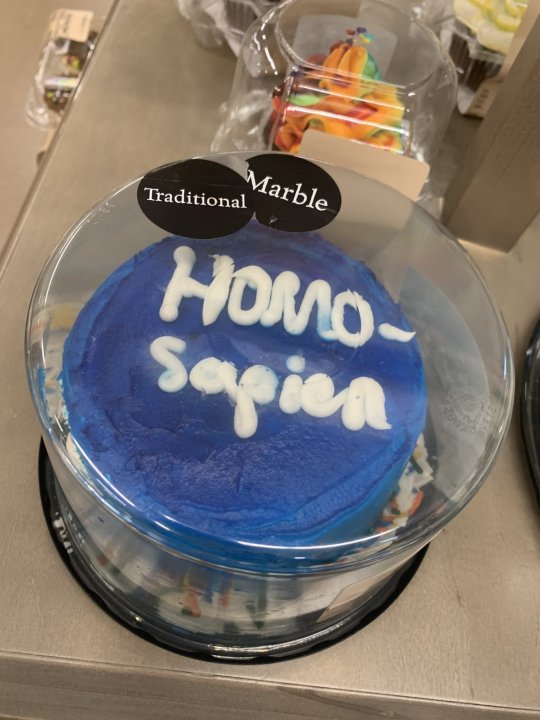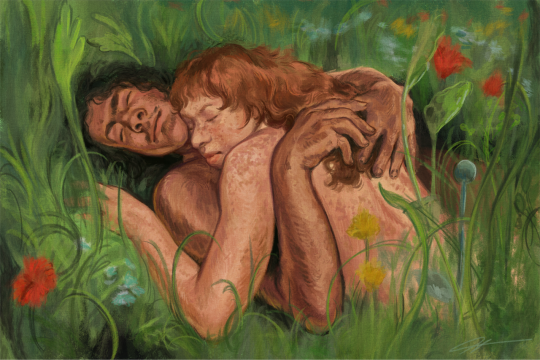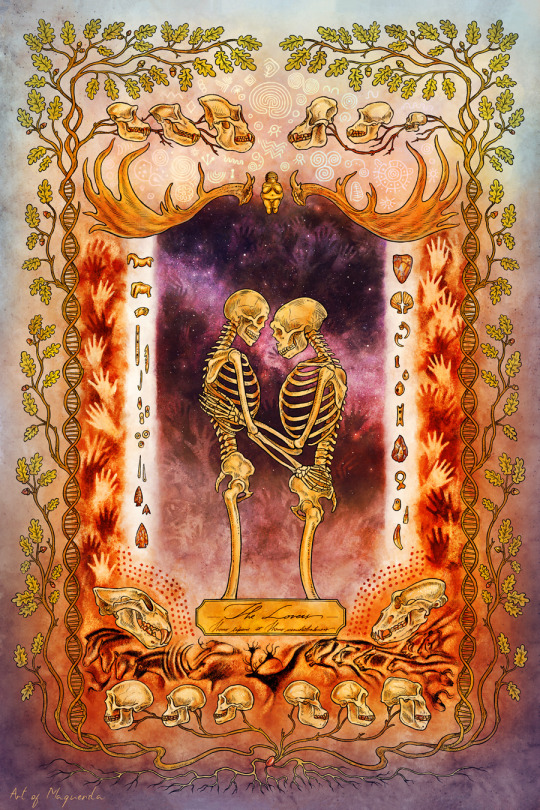#homo sapien
Explore tagged Tumblr posts
Text


Jebel Irhoud !
Jebel Irhoud or Adrar n Ighoud, is an archeological site located just north of the locality known as Tlet Ighoud, approximately 50 km (30 mi) south-east of the city of Safi in Morocco.
It is noted for the hominin fossils that have been found there since the discovery of the site in 1960.
Originally thought to be Neanderthals, the specimens have since been assigned to Homo Sapiens and, as reported in 2017, have been dated to roughly 300,000 years ago (286±32 ka for the Irhoud 3 mandible, 315±34 ka based on other fossils and the flint artefacts found nearby).
#art#history#archeology#humanity#jebel irhoud#tlet ighoud#morocco#fossil#neanderthal#specimen#homo sapien#stone age#middle stone age#SKULL#humanking#africa#genome data#paleothropy#paleanthroplogy#anthropology#human origins
49 notes
·
View notes
Text
Gc's with younger siblings go crazy get 25 grillion notifications in a row and it's just the gamers playing 'I'm not touching you' in the gc instead of the car @gec-co

#normal#normal human behavior#homo sapien#animal kingdom#Human breathing alive and normal#nature documentary#real life encounters#My story#survivor
8 notes
·
View notes
Text

10 notes
·
View notes
Text
HOMO SAPIENS APPRECIATION POST
My favorite fact about Homo Sapiens is that we all share ancestors with each other. Each human is undeniably interconnected to one another no matter how many thousands of years apart. We all have our shared great great granpappy, Oog. We all stem from Africa, and before that: the ocean. (according to modern science)
Genetically speaking, we are all family. A big homo family. 😄

2 notes
·
View notes
Text
The Tree of Unanswered Questions (Answered)
By Arjuwan Lakkdawala
Ink in the Internet
I have often been confused by the theory that we are primates, and that chimps and humans have 98% DNA similarity, and therefore it is "evidance" that we are primates. Darwin's Theory of Evolution by Natural Selection is often cited by many as the backing for this claim, or that it is at the root of it.
I decided to investigate the claims regarding human evolution to the best of my ability. I wanted to get answers that would be clear for people who have not studied human evolution. It's one of the toughest research I have done.
Evolution in itself is such a sprawling subject, one would not know from where to begin.
I decided to make it as simple as possible, I would write the subject as a tree. My own version of the evolutionary tree, not the scientific one with its many intricate details and dead ends. Because to understand that most regular readers might lose their brain cells. I say this because anyone doing research on human evolution will find quotes like "it's complex" "not enough fossil evidance" "it's a tangled web." and so on.
So here I start, let us speak about the highest branch first.
Branch 1 - Hominins (ancient human species)
Early humans are called hominins and there are according to evolutionary biologists many extinct species of humans from the genus Homo, but we the Homo Sapiens are the only living ones on earth.
In this branch there is Homo Erectus (upright human) this species is said to be the first "most human-like ancient hominin."
It is said that ancient hominins first appeared on earth six million years ago and they walked on four.
Bipedalism - the ability to walk on two legs evolved four million years ago in humans.
So Homo Erectus are the first to walk on two, they lived two million years ago, until at least 250,000 years ago.
I have seen online artificial imagineering of their faces, and you get a human face according to the artificial intelligence software.
But according to evolutionary biology they are not modern humans.
As with the example of Homo Erectus many hominin fossils have been found, and basically each has been classified as an extinct ancient human species.
There are hominins thought to be older ancrstors to Homo Erectus and those are called "super archiac."
Then in the branch after many hominins comes two of our most famous and closest cousins the Neanderthals and Denisovans.
Again not modern humans according to scientific classification.
Neanderthals went extinct about 40,000 years ago.
Denisovans are said to have gone extinct 40,000 to 30,000 years ago.
Denisovans are closer to Neanderthals than modern humans according to the science.
It is said Neanderthals and modern humans interbreeded.
There is no explanation as to why or how Neanderthals became extinct.
How does evolution take place? Answer: By mutations.
According to the science of evolution it happens in two types of periods.
1. The Microevolution (short period) in this period minor changes get made to species according to natural selection. The difference in anatomy is considered not to be significant.
2. The Macroevolution (long period) in this period great changes get made to a species, and even evolving it into a whole new species.
But there has to be the existence of an intermediate species in the chain or branch of evolutionary changes.
Example:
Charles Darwin was hoping to get palaeontological evidance of an intermediate species. Two years after the publication of his book 'On the Origin of Species' the fossil 'archaepteryx' was found. The fossil link between birds and dinasaurs.
"This extraordinary fossil—bearing feathers as well as teeth, claws, a bony tail and other reptilian traits—was just the sort of creature that Darwin’s theory of evolution by natural selection predicted should exist. The feathers left no question that the Jurassic Archaeopteryx was a bird, but the creature also had a suite of saurian traits that pointed to a reptilian ancestry." - Smithsonian Megazine
However, anthropologist Briana Pobinar, says that the term "Missing Link" is not accurate because it depicts a linear chain in evolution, which is not the pattern they see.
Pobinar says evolution “produces a tree-like branching pattern with multiple descendants of an ancestor species existing at the same time, and sometimes even alongside that ancestor species.” - Smithsonian Megazine.
The human that is supposed to connect modern humans with primative ancestors has never been found.
So much so that it appears that it's a "ghost" species. What it means is that there is no fossil or DNA evidance to make a scientific connection.
In fact a new study published in Nature Journal challenges previous notions about hominin contribution to modern Homo Sapiens.
"New model for human evolution suggests Homo sapiens arose from multiple closely related populations.
A new study in Nature challenges prevailing theories, suggesting that Homo sapiens evolved from multiple diverse populations across Africa, with the earliest detectable split occurring 120,000-135,000 years ago, after prolonged periods of genetic intermixing." - Scitech Daily
This means that modern humans evolved from similar other modern humans. There is no genetic evolutionary notable impact from primate like hominins.
(Study is very new released in May 2023)
So what really makes modern humans different to so called other species of humans. I would say it's the brain and cognitive ability, and this brings me to the second branch of the tree.
Branch 2. (Human Brain Development)
The fossils so far found of "extinct human species" help scientists determine bone structure and facial features of those individuals, but brain tissue is not preserved well, so scientist know little about the cognitive abilities of these species.
So archealogy is the best option for researchers to try and understand the thinking abilities of more recent species like Neanderthals and Denisovans.
As I have read in an article, this too is extremely complicated, as it raises the question are the primitive tools found in excavations and cave paintings really a sign of limited intelligence or underdeveloped environment. Can we really assume that Neanderthals and Denisovans if in a modern world would not be able to think like a modern human?
Researchers have observed differences in brain case size of extinct humans. But does this imply higher or lower cognitive abilities.
To answer to this question or shed some light on it as I was so curious, I decided to take my research from evolutionary biology, history, and archaeology to neuroscience and investigate the development of the human brain.
The confusion of brain development and cultural effect is because of neuro plasticity. In a study done chimps it appeared had rigid neuro plasticity compared to humans. So what is brain plasticity? It is the brain's ability to rewire itself structurally and functionally according to experience and injury. There are even ongoing studies about if plasticity itself can evolve. The more plasticity the stronger cognitive abilities.
Neuroscience is one of the hardest and active field of research. So I'll not get into other aspects of the brain. Here I'll examine the aspect of brain development in regard to neuro plasticity.
"The neocortex—the outermost layer of the brain characterized by the squiggly sulci, or brain folds—is the region that gives all primates their exceptional intelligence. In both chimps and humans, this brain region continues to grow and organize for years after birth, allowing us to learn and develop socially. The brain's ability to reorganize in response to environmental cues is known as plasticity, and it is this flexibility that allows us to learn things we never knew at birth." - Science.org
There lingers the question of brain size regarding the hominins or Neanderthals, Denisovans, if brain tissue of their fossils cannot be examined, we can instead try to find out if a larger brain (large brain cases of fossils) mean higher intelligence or the ability for modern human cognition.
"Having an unusually large brain doesn't necessarily make someone a genius, and large-scale research suggests only a slight and tenuous relationship between brain size and intelligence." - Psychology Today.
With this I conclude the second branch, and start the third branch which is about intelligence in apes and other animals.
Branch 3. (Intelligence in the animal kingdom)
Animals that have shown high Intelligence in comparison to most animals are apes, parrots, crows, ravens, mice, elephants, dogs, and new research suggests octopuses.
"The more that researchers examine octopus genetics, brains and sensory capabilities, the more they find startling similarities to our own minds, hand in hand (or sucker-covered arm in sucker-covered arm) with bizarre differences between how our species experience the world." - Discover.
However, there is nothing close to the level of human intelligence.
Charles Darwin had based his theory on physical changes, he did not know about genetics.
The Theory of Evolution incorporated with the study of genetics is called 'Modern Evolution Synthesis."
What I have done in this tree is summarise the theory of human evolution based on physical and biological research.
What I have found is so far scientifically there is no fossil or genetic evidance that says Homo Sapiens evolved directly from apes.
We are in the 21st century with sophisticated technologies and molecular biology. There is nothing stopping scientists from searching for fossil or genetic evidence except that it can't be found.
Neanderthals and Denisovans have said to have existed in the Ice Age, and there were hominins in the Stone Age.
Copyright ©️ Arjuwan Lakkdawala 2023
Arjuwan Lakkdawala is an author and independent journalist. Twitter: @Spellrainia Email: [email protected]
Sources:
Metode Science Studies Journal, 7 (2017)
Human Brain Evolution - How increase in brain plasticity made us a cultural species - Aida Gomez Robles and Chet C. Sherwood
What Is Neural Plasticity?
Rommy von Bernhardi et al. Adv Exp Med Biol. 2017.
Smithsonian Megazine - Riley Black, Natural History Museum- Katie Pavid
Natural History Museum- Josh Davis
National Geogrphic - Tim Vernimmen
YourGenome.org - Society and Behaviour
Australian Museum - A Timeline of Gissil Discoveries - Fran Dorey
Britannica - Homo Sapiens
Smithsonian: National Museum of Natural History - Introduction to Human Evolution
Live Science: What is Darwin's Theory of Evolution - By Ker Than, Ashley P. Taylor, Tom Garner
Discover Megazine
Psychology Today
Daniel Graham, Ph.D.
A Bigger Brain is Not Necessarily Better
Science.org - David Shultz
New DNA Research Changes Origin of Human Species -
Scitech Daily - University of California - Davis
National Library of Medicine - National Center for Biotechnology Information -
Front Hum Neurosci. 2013; 7: 707.
Published online 2013 Oct 30. doi: 10.3389/fnhum.2013.00707
PMCID: PMC3812990
PMID: 24194709
Evolution, development, and plasticity of the human brain: from molecules to bones
Branka Hrvoj-Mihic,1,2 Thibault Bienvenu,1 Lisa Stefanacci,1,2 Alysson R. Muotri,2,3 and Katerina Semendeferi1,3,*
What may have given modern humans an edge over Neanderthals, according to new research
By Katie Hunt, CNN
Study.com - People and Society in the Stone Age
Jessica Holmes, Joanna Harris
#biology#evolution#science#arjuwan lakkdawala#nature#genomes#animals#Neanderthals#Denisovans#hominins#homo sapien#homo erectus#charles Darwin#neuroscience#neuroplasticity#apes#tree#theory of evolution#on the theory of origin
2 notes
·
View notes
Text


Skulls for a poster 🦴🦴🦴 (horse, lion, and human ofc)
#art#sketch#digital art#digital sketch#illustration#scientific illustration#skulls#anatomy#horse#horse skull#equus caballus#lion#panthera leo#human skull#homo sapien#strigoium’s college art
2 notes
·
View notes
Text

My attempt at a wise human (Homo sapien) profile.
#animal art#human art#homo sapien#human#wise human#human drawing#2D art#2D digital art#digital art#graphic design#character design#species design
0 notes
Text




went to the grocery store today and i was very pleased by their pride cake selections
#the transformer one fucks i really want to go back and buy it.#i should add: the homo sapien one was the color of the gay man flag but you cant tell in the pic
64K notes
·
View notes
Note
I went to the dollar general with five dollars and got some off brand pop tarts, ate one and decided it tasted weird. So I set the other aside, came back to it a couple of hours later and realized it had black mold on it, like a lot of it. So in case I end up with a not so bright fate, I would like to know what creature I get!
String identified: t t t a ga t a a gt a tat, at a c t tat . t t t a, ca ac t t a c at a a t a ac t, a t t. ca t a t gt at, t at cat gt!
Closest match: Homo sapiens genome assembly, chromosome: contig-113 Common name: Common Human

(image source)
#tumblr genetics#genetics#biology#science#asks#requests#sent to me#moth-o170#jerma#jerma985#common human#human#homo sapiens
6K notes
·
View notes
Text

Sapien boy and neanderthal girl doze in the springtime, finally together again
#art#neanderthals#homo sapiens#love#spring#artists on tumblr#ancient human love...spring time...#likes and reblogs are super appreciated :'0)
20K notes
·
View notes
Note
Omg ur "Homo" "Sexual" 🤬🤬🤬
Yes fight me
1 note
·
View note
Photo

Sites of the earliest known Homo sapiens remains
440 notes
·
View notes
Text

The Lovers
This drawing is a tribute to the shared origins of humanity, a reminder of the ancient ties that bind us across time. In contemplating deep time, the vast stretches of history that have shaped us, I feel a profound sense of connection to those who came before us, whether our direct ancestors or other early hominids. The Neanderthals, along with other early hominids, coexisted with us and were not so different; they loved, they dreamed, and they faced the world with curiosity and wonder. This connection is even imprinted in our DNA, a living testament to the bonds we share with these ancient relatives.
By reflecting on our similarities, I am reminded that the essence of our humanity has always been rooted in relationships, in the bonds we forge with others. This connection extends beyond just the human lineage, reaching back to the many hominids who once walked this Earth, and even to our living relatives among the primates. We are part of a vast, interconnected family, linked by our shared journey through deep time.
In this image, I seek to capture the timeless nature of love and the shared journey of our species and our kin. This is not just a story of survival, but one of enduring connection, of two souls meeting across the millennia. In their embrace, I see a reflection of our own struggles and hopes, a reminder that despite the passage of time, the essence of what makes us human and what connects us to all life, remains unchanged.
We are all part of a continuous, unbroken lineage, connected by the deep and ancient roots of our existence. Prints are available: https://artofmaquenda.etsy.com/listing/1786867243/the-lovers-lustre-print-hominid-sapiens Thank you all for your kind messages and support on my WIP posts! It took me a while to finally dive into this piece, but it just needed the right moment to come together. <3
The lettering is done by the kind Urukins / Antiqueuru
#hominids#sapiens#neanderthalensis#neanderthal#homo sapiens#evolution#nature#venus von willendorf#flute#tree of life#dna#the lovers#tarot#paleo art#paleo#skeletons#primates#art#artofmaquenda#maquenda
585 notes
·
View notes
Text

Just a cave girl and her fursona 𐂂
#my art#art#illustration#artists on tumblr#digital illustration#digital sketchbook#illustrators on tumblr#character design#cave paintings#cave art#fursona#furry art#early humans#homo sapiens#Neolithic#Paleolithic#sorry y’all I’m just sort of using tags at this point#irish elk#deer furry
212 notes
·
View notes
Photo

7:37 PM EDT October 20, 2024:
Parquet Courts - "Homo Sapien" From the album Sympathy For Life (October 22, 2021)
Last song scrobbled from iTunes at Last.fm
Another Parquet Courts album, another stupid review from Pitchfork for it
--

0 notes
Text
Me when I leave the gathering

#shitpost#pride#pride month#lgbt#lgbtq#lgbtqia#lesbian#bisexual#gay#trans#transgender#asexual#aromantic#pansexual#agender#nonbinary#queer#meme#later homo#homo#homo sapien
91 notes
·
View notes